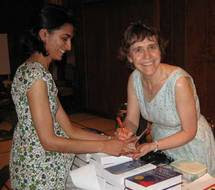 |
| Wordlady's famous pointe shoe cookie |
We in North America call these sweet treats "cookies" thanks to the Dutch, for whom small cakes (koek, pronounced "kook") were koekjes (kook-yuhz).
The British call them "biscuits", a word borrowed from Old French in the 1300s and ultimately derived from the Latin word biscoctum, literally "twice baked". In the middle ages, small flat cakes were cooked twice to dry them out and ensure long keeping. This is also the source of the word "biscotti", a type of cookie which is literally twice baked.
The interesting thing about the word "biscuit" is its spelling. For 300 years, from the 1500s to the 1700s, we quite sensibly spelled it "bisket", to reflect the pronunciation. But once again English's allergy to sensible spelling reared its ugly head, and sometime in the 1700s, when it was trendy to borrow French words, we committed what the OED disapprovingly refers to as "a senseless adoption of the modern French spelling, without the French pronunciation".
Here in Canada, we have a particular saying, "to have had the biscuit", meaning to be worn out, useless, no longer functioning, etc. This is not to be confused with the British English expression "take the biscuit" which means "be the most remarkable or foolish of its kind". We in North America would say "take the cake" instead.
Just to add to the confusion, North Americans do use the word "biscuit" (in Canada often "tea biscuit"), but for a small not-too sweet cake more like a scone (for more on scones, see this post).
Here's my favourite recipe for rolled cookies, along with a hot tip for making the rolling more convenient and less messy. These hold their shape really well as there is no baking powder in the recipe to make them spread and puff up.
7 oz (200g) soft butter (NOT margarine!)
1 1/4 cups sugar
1 1/2 tsp vanilla
1 egg
3 cups flour (400 g)
(for chocolate cookies, replace 1/3 cup of the flour with 1/2 cup of cocoa)
Beat butter, sugar, and vanilla together for 2 minutes. Add egg and beat for another 30 seconds. Beat in flour on slow speed until dough clings together, finish with hands to make a smooth ball of dough. Divide in two and put each smaller ball into a large zipper-closure freezer bag. Chill for about 1/2 hour to an hour.
With dough still in bag, roll out (ie you will be rolling your rolling pin on top of the plastic) till it is a square of even thickness (about 1/4 inch) completely filling the bag (you may have to turn the bag over, and open the "zipper" occasionally to remove creases and air bubbles). Open the zipper closure, run a knife down the side edges of the bag and peel the top side of the bag off the cookie dough (it won't stick). If you want to decorate the cookies with coloured sugar, sprinkles, etc., spread them over the cookie dough, fold the plastic back over it and run the rolling pin lightly over the whole surface just so the decorations cling to the dough. Cut out shapes. Place on parchment paper on a cookie sheet and bake at 350 degrees until top of cookie is no longer soft (varies from 5 to 12 minutes depending on size of cookie).
Gather any trimmings and reroll.
The advantage of using the freezer bag is that you don't need to flour your board or rolling pin, which means that the cookies don't get tougher as more flour is added to them, and you also have a lot less cleanup.
A tip if you want to make cat cookies: If you have friends with an orange "marmalade" cat, make the cookie dough substituting orange extract for the vanilla and enough red and yellow food colouring to tint a deep orange colour. Mix in about 1/3 cup of orange sprinkles before rolling and cutting out with cat-shaped cookie cutters. The sprinkles will look like tabby markings when the cookies are baked.
For instructions on how to make the pointe shoe cookies, click here.
Recipe can be doubled if you need many many cookies (and who doesn't?)

The reference to the Italian word biscotto (plural biscotti, any kind of cookie in Italian) reminded me of an article about a totally different meaning the word biscotto can have in Italian, which was picked up by a number of English-speaking media last year – a stitch-up (see Italians bitter on 'biscotto').
ReplyDeleteThe metaphorical usage refers to the practice of doping cookies that were then given to racehorses.
fascinating!
Delete